Have you ever noticed splotches on your cast iron pan after seasoning it? Well, you’re not alone. This is a common issue that leaves many individuals puzzled as to its cause. There are various reasons why your cast iron cookware may have a spotty finish after seasoning, such as using the wrong oil or not cleaning it correctly. This article will discuss the common reasons for a splotchy finish on cast iron cookware and provide solutions to help you achieve a consistently seasoned surface.
What Is Cast Iron Seasoning?
Cast iron seasoning is a method of adding a protective layer of oil to your cookware that prevents rust and adds a smooth, non-stick surface.
This coating is created through repeated heating and adding layers of oil over time. In order to ensure the best results, you must use an oil that will not break down or polymerize easily when exposed to high heat, such as flaxseed oil or coconut oil.
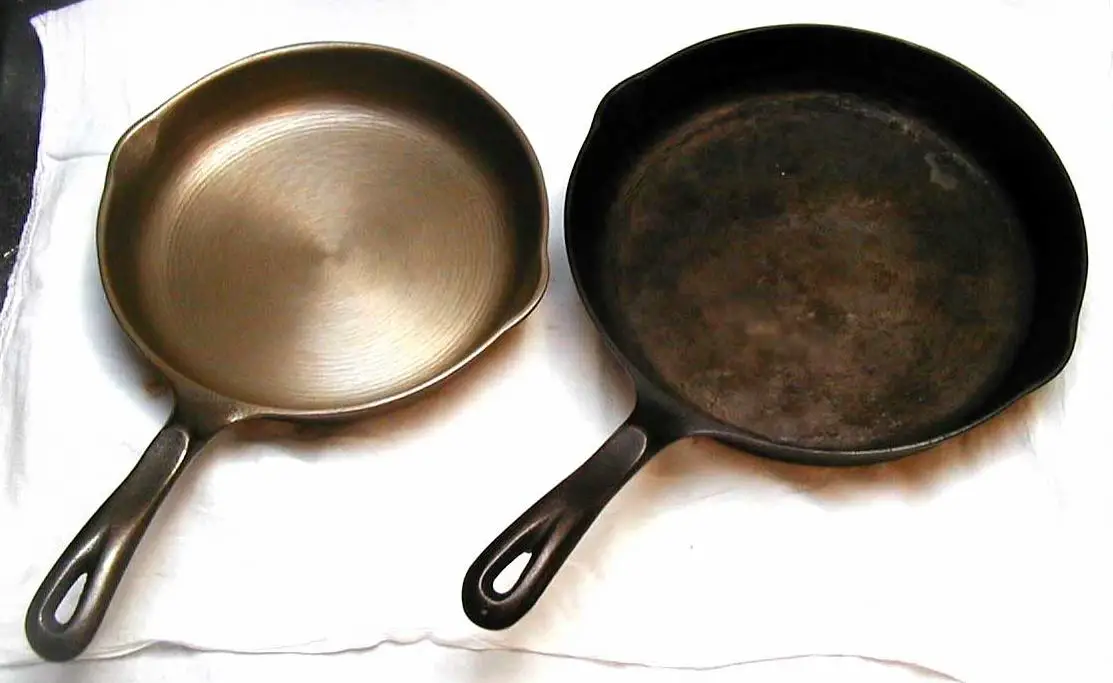
Additionally, you must use a light-touch technique when applying the oil in order for it to build up correctly and evenly.
What Does Uneven Seasoning Look Like?
Uneven seasoning is a frequent issue with cast iron cookware. If you’ve recently seasoned your cookware and noticed patches of oil residue that are either too shiny, too dark or just patchy in general, then this is an indication that your seasoning was not done correctly.
There are a few steps you can take in order to ensure that the seasoning is even. First, make sure that you apply an even layer of oil all over the cookware with a paper towel.
Second, use an oven or stovetop to heat the cookware until it is hot enough for the oil to start smoking. It is important to allow the cast iron cookware to cool down completely before repeating these steps several times before you start using it.
What Should Seasoned Cast Iron Look Like?
A properly seasoned cast iron should have a dark, non-stick surface that is smooth to the touch. You will notice that your cookware has a glossy finish, unlike unseasoned cast iron. There could be a few reasons why your cast iron looks blotchy or streaky after seasoning. [1]
Why Is My Cast Iron Splotchy After Seasoning It?
Cast iron skillets are a timeless kitchen staple, providing years of cooking excellence with regular care and maintenance. To maintain the excellent non-stick properties of cast iron, it’s crucial to season it properly. Seasoning is usually done by rubbing the interior surface with oil or fat and baking it in the oven to create a slick, almost glass-like coating of polymers.

Sometimes, seasoning can cause the surface to appear uneven or splotchy, which can affect its visual appeal and performance.
So why is your cast iron splotchy after seasoning? Insufficient preheating before applying the oil or fat is the primary reason for the issue.
How To Fix Uneven Cast Iron Seasoning
Using a cast iron skillet for cooking can be an enjoyable and satisfying experience, but it may be challenging to achieve consistent seasoning across the entire surface of the skillet. This problem is commonly caused by the presence of oil residue from the previous cooking in the pan. Fixing uneven seasoning on your cast iron skillet is easy!
There are several solutions to this problem, but one of the most effective is to re-season the skillet. Begin by wiping off any remaining oil or residue from the pan with a damp cloth. First, apply a thin layer of cooking oil to the pan and ensure it is spread evenly, then place it in the oven at 375°F and leave it to heat up for 30 minutes. After finishing, allow the pan to cool down and use a cloth to remove any excess oil. Your cast iron skillet should now have a uniform seasoning. [2]
How To Re-Season Cast Iron Cookware
The process of re-seasoning your cast iron cookware is simple. To proceed, please prepare high-heat oil like vegetable or canola oil and a rag or paper towel.
To clean your pan, use warm soapy water and a brush or sponge.
Rinse the pan with warm water to remove any soap residue and make sure to completely dry it afterwards.
Either use your hands or a rag to apply a thin layer of oil onto the surface of the pan.
To prepare, put the pan upside down on a baking sheet and bake in the preheated oven for an hour.
Please switch off the oven and wait for the pan to cool down completely.
Wipe away any excess oil with a paper towel or rag.
Repeat steps 4-7 two or three times, depending on how badly your pan is seasoned.
Store the pan in a dry, warm place after it has cooled down completely.
How Many Times Should You Season Cast Iron?
For optimal effectiveness, some experts suggest seasoning your cast iron cookware up to 10 times, although it is widely accepted to season it between 3-4 times. When it comes to seasoning your cookware, the key is to be patient and methodical. The more you season it, the better nonstick surface will form.
The Best Oils For Seasoning Cast Iron
For seasoning a cast iron, certain oils are more suitable than others. To season your cast iron cookware, the recommended oils are flaxseed oil and grapeseed oil. When applied for seasoning cast iron, both of these oils produce a tough and long-lasting coating. They also impart a nice flavor without compromising the natural non-stick properties of your cookware. Other oils, such as vegetable and canola oil, may not create the same protective layer that these two do.
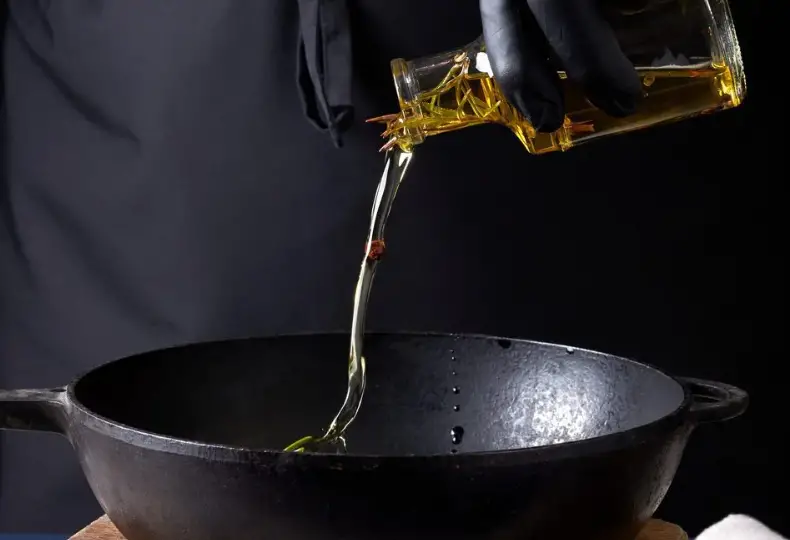
Additionally, some oils will leave an unpleasant taste if used for seasoning. Using the appropriate type of oil is crucial for achieving optimal outcomes while seasoning your cast iron cookware. [3]
How to Clean Sticky Cast Iron
To ensure that food does not stick to the surface of cast iron cookware, it is recommended to season it before its first use. This also helps to make the cookware non-stick. If your cast iron appears blotchy or uneven after seasoning, there are steps you can take to address the problem. One option is to clean the sticky area with a mild detergent and warm water, using a sponge and coarse salt for scrubbing.
Afterward, dry the cast iron thoroughly with a clean cloth to prevent rusting. Once it’s completely dry, season the cookware with vegetable oil or shortening by rubbing it over every surface of the pan or skillet.
Afterward, put the cookware in an oven that has been preheated to 350 degrees and let it cook for around one hour. Make sure to let it cool down completely before utilizing it. You may need to repeat the process a few times if the splotchy area persists in order to resolve it.
What Can You Not Cook in Cast Iron?
Cast iron is a good choice for cooking, but there are certain foods that should not be cooked in it.
These include acidic items such as tomatoes or citrus juices, foods that require high heat and intense bubbling (such as macaroni and cheese), delicate fish filets, and anything with a lot of moisture like steamed vegetables.
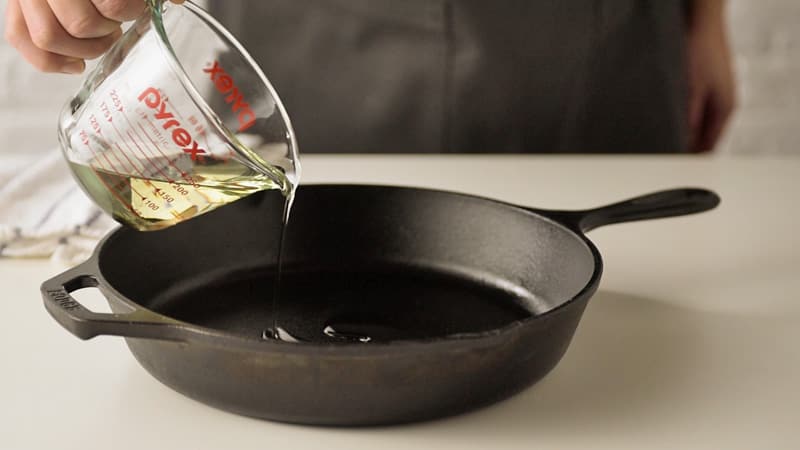
Additionally, it is not a good idea to cook delicate sauces in cast iron as they may take on the taste and color of the pan. For these types of dishes, you should use a different type of cookware.
Make sure to clean and season your cast iron skillet thoroughly after cooking any of these things in it. This will help to prevent buildup which could lead to the splotchy appearance described earlier. For the best results when using a cast iron skillet, it’s recommended to prepare traditional dishes such as bacon and eggs. [4]
FAQ
What are the white spots on cast iron pots after seasoning?
The white spots on cast iron pots after seasoning are a result of residual food particles that were not removed during the pre-seasoning process. These things are not dangerous and can be removed easily using a scrub brush, steel wool, or scouring pad. If the spots remain after cleaning, they may indicate improper seasoning or insufficient heat when seasoning was applied. In this case, it is best to re-season the pot following the manufacturer’s instructions.
Should seasoned cast iron be smooth?
The cast iron should not be smooth after seasoning. Even after being seasoned, it’s typical for a cast iron pan to have a slightly bumpy or pebbled texture. This provides the necessary insulation from heat and prevents food from sticking while cooking. Seasoning also creates a thin layer of oil on the pan that acts as a lubricant, making it easier to clean and maintain.
What happens if you season cast iron too long?
In summary, it is a good idea to season your cast iron as it provides protection to it. But if you season it too long or with too much oil, the excess can accumulate over time and create an uneven, splotchy finish. This is especially true when using vegetable oils like peanut oil which are not as stable as animal-sourced fats. To prevent issues, only season your cast iron until the surface becomes non-stick and shiny. Afterwards, remove any extra oil before storing it.
Moreover, if you notice unevenness in the seasoning of your pan due to prolonged usage, you can restore it by cleaning the pan and reapplying the seasoning process. Your cast iron skillet can last for many years if you take good care of it and maintain it properly.
In conclusion, splotchy cast iron is usually the result of over-seasoning or using an unstable oil.
To avoid this issue, season your pan only until the surface has developed a non-stick coating and wipe off any excess oil before storing away. To fix splotchy seasoning on your pan due to extended use, clean the pan and repeat the seasoning process.
Why is my cast iron not shiny after seasoning?
Although cast iron is durable, it needs maintenance to maintain its appearance. Seasoning your cast iron cookware properly is essential, but it’s not uncommon to experience splotchy or uneven surfaces afterwards. This could be due to insufficient oil during the seasoning process, applying too much oil, or using the wrong type of oil. A common mistake in seasoning cast iron is not using enough oil when cooking. Remember to coat the entire surface of the skillet with just enough oil, without allowing it to gather in one spot. This will ensure a perfectly even and non-stick surface for your cooking needs.
Why does my cast iron pan look rusty after seasoning?
If you own a cast iron pan, then you’ve probably experienced the issue of blotchy rust appearing after seasoning. Fear not! Uneven application of seasoning oil or inadequate curing is usually to blame. To maintain a beautiful, well-seasoned pan, it’s crucial to evenly apply the seasoning oil and properly follow the curing instructions. Discover how to bring the shine back to your splotchy cast iron pan!
Simply re-season it or use a rust remover to get it looking like new again. With proper maintenance, your cast iron pan can keep its perfect seasoning for years to come.
How long to wait after seasoning cast iron?
To ensure a flawless seasoning on your cast iron pan, it’s crucial to let it cool down entirely before starting the process. This is because hot pans can prevent oil from adhering correctly, leading to an uneven and spotty finish. You can achieve a more even coating by allowing the pan to cool completely or reheating it before applying the oil.
Additionally, some experts recommend smoothing out any blotches by rubbing a thin layer of shortening after seasoning.
Why does my iron have brown spots?
Interested in perfecting your cast iron cooking skills? When it comes to seasoning your pan, don’t be alarmed if you notice some splotchy brown spots forming on the surface. This is completely normal and caused by uneven heat during the seasoning process. However, to prevent this from happening, opt for an oil with a high smoke point (like peanut or vegetable oil) and make sure your pan is heated slowly and evenly until the oil smokes. With these tips, you’ll be able to achieve flawless seasoning every time. Keep your seasoned pan dry and away from moisture storage.
Always avoid washing your cast iron with soap because it breaks down the seasoning. Instead, use a scraper to remove stubborn food and rinse with hot water.
Do you clean cast iron after seasoning?
Cleaning your cast iron after seasoning is important. Using this will prevent food particles from sticking to the surface of the pan and potentially damaging it. In addition, you may also want to wipe it down with a light coat of oil or cooking spray to help protect the seasoning and keep it looking nice. Maintaining your cast iron is easy and essential – use warm water and non-abrasive soap for regular cleaning. Remember to dry your pan completely before storing it away.
Also, make sure to avoid putting your cast iron in the oven post-seasoning, as it may ruin the seasoning with splotches. Keep your cast iron in its best shape with these simple tips. This is due to the intense heat of the oven which can cause areas that have been seasoned to start becoming uneven in color.
To ensure that your cast iron remains in good condition, it’s recommended to season it away from the oven or stovetop where the heat source is direct. Using this technique will maintain the consistent flavor throughout.
What removes seasoning from cast iron?
Attention all cast iron skillet users! Removing seasoning from your skillet can be challenging, but don’t worry – we’re here to provide you with the best tips and tricks. With a bit of patience and the correct tools, you can succeed! Unseasoned cast iron can be tricky to use, so it’s essential to remove any existing seasoning before applying a new layer. Keep reading for our tried and tested methods.
Can you wash off cast iron seasoning?
Learn how to easily wash off cast iron seasoning with these simple steps. Start by heating up some water in a pot on your stove, adding some dish soap to it. Once the water is hot, scrub away at the seasoning with a sponge until it’s completely gone. Make sure to rinse off any soap residue before using a paper towel to dry your cast iron. For an even easier method, try using a baking soda and water paste to speed up the process. Say goodbye to stubborn seasoning and hello to a clean and refreshed cast iron.
Also, remember to oil the surface after you’ve washed it off, as this will help prolong its life. With the right steps and proper maintenance, your cast iron cookware can stay in perfect condition for years to come. A well-seasoned pan not only looks great but also ensures that food won’t stick when cooking delicious meals.
Useful Video: Why Is My Seasoning Splotchy?
Conclusion
Cast iron turning splotchy after seasoning is probably caused by inappropriate cleaning or insufficient oiling and baking. Make sure you clean and oil your cast iron cookware before every use to keep it in excellent condition.
Additionally, you can also bake the cookware in the oven after thoroughly coating it with oil for a longer lasting seasoning. If you find your cookware is still turning splotchy, consider re-seasoning it altogether.
References
- https://campfiresandcastiron.com/splotchy-skillet-how-to-fix-uneven-cast-iron-seasoning/
- https://foodsguy.com/cast-iron-sticking-after-seasoning/
- https://www.americastestkitchen.com/guides/cook-it-in-cast-iron/cast-iron-troubleshooting
- https://www.lodgecastiron.com/discover/cleaning-and-care/cast-iron/troubleshooting





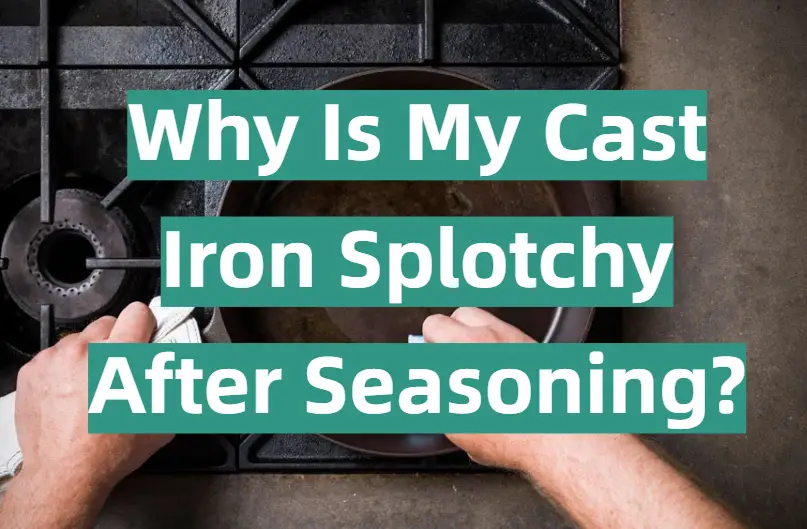



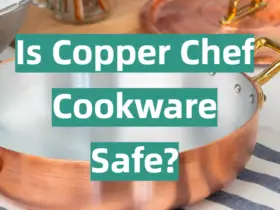

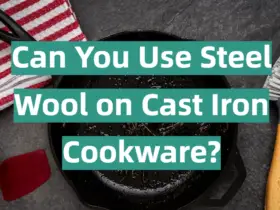
Leave a Reply